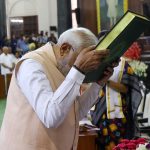The Indian government conducted another test of the country’s emergency alert system on Tuesday morning, causing millions of mobile phones across the country to sound a loud alarm tone. The test was part of an effort by the National Disaster Management Authority (NDMA) to evaluate and improve India’s ability to rapidly communicate with the public during crises.
A Nationwide Test
Around 11:35 AM on Tuesday, October 10, 2023, Android and iPhone users throughout India received an emergency alert consisting of a flash message and loud beeping tone. The English and Hindi messages informed recipients that this was a test of a new “Pan-India Emergency Alert System” being implemented by the NDMA to “enhance public safety and provide timely alerts during emergencies.”
Pan-India Emergency Alert System being tested by NDMA! #EmergencyAlertSystem pic.twitter.com/9woM9uR96V
— Shubham Singh (@Shubhamin94) October 10, 2023
@DoT_India I am getting this alert message. Please confirm whether this message is broadcast by DoT and NDMA. pic.twitter.com/6dpDAQfo6P
— gaurav verma (@g9457846841) October 10, 2023
This test marked the sixth time since August that the government has sent these “Emergency Alert – Severe” messages to evaluate the effectiveness of the system. The messages are being transmitted using Cell Broadcast technology, which allows text messages to be sent simultaneously to all mobile phones in a specific area, regardless of the network operator.
Enhancing Emergency Communication
The alerts are a collaboration between the Department of Telecommunications (DoT) and the NDMA to improve emergency communication during disasters and other threats to public safety. According to Rajkumar Upadhyay, CEO of the Centre for Development of Telematics (C-DOT), the cell broadcast system is currently undergoing testing on the Jio and BSNL networks.
The system aims to directly send alerts to mobile screens during emergencies, improving on previous systems that relied on television, radio, and sirens. Cell Broadcast is uniquely suited for this purpose, as it can quickly disseminate messages to all mobile users in a geographic area without causing network congestion.
Also Read: Empowering Women’s Mental Health: Associations Unite for Mentoring Walk on World Mental Health Day
Identifying and Resolving Issues
By conducting periodic tests, the NDMA and DoT aim to identify any gaps in the system’s effectiveness, coverage, or implementation. The tests help ensure the technology works as intended and that messages are displayed and communicated properly across different mobile devices, networks, and languages.
The government can then work to resolve any issues before the system is relied upon during an actual emergency. The alerts complement other public warning systems, providing a crucial additional channel to inform citizens of threats and safety advisories.
Empowering Citizens through Information
Rapid, mass communication of emergency information empowers citizens to take appropriate action to protect themselves and their families. By testing this system now, the Indian government aims to ensure it can effectively utilize cell broadcast technology to disseminate potentially life-saving information to the public when the next disaster inevitably strikes.
While Tuesday’s alert may have caused momentary concern for some mobile users, it ultimately represents a step toward a future in which emergencies need not result in preventable tragedy. A robust and reliable emergency alert system can mitigate harm, panic, and confusion – but only if the technology is tested and refined ahead of time.
Developing an Indian Solution
Currently, the cell broadcast technology is only available from foreign vendors. To reduce dependence on imported systems, C-DOT is developing an indigenous cell broadcast platform tailored to India’s needs.
According to Upadhyay, “There are various versions of the cell broadcast messages that need to be developed for propagation through the telecom network.” Creating a made-in-India system will enable easier integration with local telecom infrastructure, ensure supply security, and give the nation greater control over a critical emergency response capability.
Also Read: IT Consultant Loses Rs 3.8 Lakh in Fake Online Hotel Booking
Cooperation Between Government Agencies
The NDMA is serving as the implementing authority for the emergency alert system, while DoT handles integration with the telecom networks. By pooling their expertise and mandates, the two organizations aim to develop a unified warning system superior to what either could accomplish independently.
DoT brings an in-depth understanding of India’s mobile networks and how to effectively utilize cell broadcast technology. Meanwhile, NDMA contributes experience in emergency management and expertise in designing effective public warning messages.
Seeking Public Feedback
While the alerts require no response from the public, citizen feedback can help improve the system. People can provide suggestions about the content, timing, frequency, and presentation of messages. Those who did not receive the alert can also report the issue to help identify gaps in network coverage.
The NDMA may conduct surveys and focus groups to gather additional insights into how the emergency alerts are working and how they could be enhanced. Public participation will help ensure the system meets the needs and expectations of the citizens it is designed to protect.
Through continued testing and refinement, the Emergency Alert System promises to rapidly transform India’s emergency preparedness and response capabilities. While such systems take time to perfect, each test brings the nation one step closer to utilizing mobile technology to empower citizens and build resilience.
Also Read: Hydrogen Trains Set to Revolutionize Sustainable Transport in Saudi Arabia and India
Follow Us on Instagram | Twitter | Facebook | YouTube | Flipboard | Google News

























